Fall Cankerworm
ID
ENTO-223NP (ENTO-404NP)
Hosts
The fall cankerworm, Alsophila pometaria (Geometridae: Lepidoptera), is a generalist feeder on all broadleaf trees. In Virginia, dense populations are most often found on species of oak along dry ridge tops as well as in urban areas.
Identification
Adults are greyish-brown in coloring. Male moths are small in size and have a wingspan of only 2.5 cm (1 inch). Adult females are wingless (Fig. 1) and resemble spiders when crawling on the forest floor or on tree bark. Larvae vary in color and can be light green, dark green, or black, often with a black stripe down the center of their back from head to tail. The larvae are small, only 2.5 cm (1 inch) in length when mature. There is a gap between the first legs and the prolegs which makes them “inch” forward as they move (Fig. 2). Fall cankerworm larvae are easily confused with spring cankerworm larvae [Paleacrita vernata (Peck)]. However, fall cankerworm has three pairs of functional abdominal prolegs, while spring cankerworm has only two.
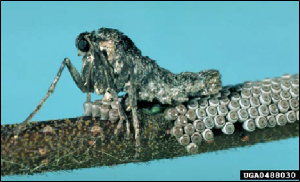
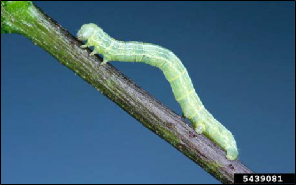
Life History
Fall cankerworm is a sporadic pest in Virginia. Years with defoliation are often followed by many years without any sightings of this pest. Adult moths emerge from the forest floor in October to November; males generally emerge before the females. After mating, the females crawl up trees in order to find suitable places to lay their eggs. Adults die soon after mating and egg-laying has occurred. One female can lay up to 100 eggs in rows on branches (Fig. 1). Egg masses overwinter and hatch in April and May. Larvae are voracious eaters feeding on opening spring buds and new leaves. Larvae are able to spin silk and use these silk strands to move from tree to tree in search of food (Fig 3). During mid to late June, larvae begin to drop to the ground to pupate in the soil. Adults then emerge in the fall and the cycle begins again.
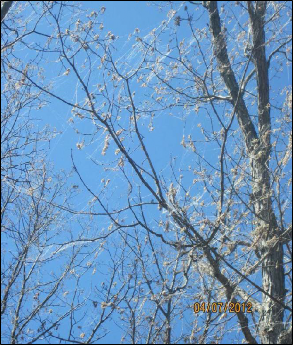
Distribution
Fall cankerworm is native to North America and found throughout the United States and Canada. According to the US Forest Service, the earliest recorded outbreak of fall cankerworm was in 1661. One hundred and two years later, the Massachusetts Society for Promoting Agriculture offered “a premium of 100 dollars to the person who shall…discover an effectual and the cheapest method of destroying the cankerworm…” (Ciesla and Asaro 2013). The fall cankerworm remains a prevalent pest today and ranks second only to the gypsy moth in terms of frequency of major outbreaks and degree of defoliation in Virginia. It was the most common recurring defoliator in Virginia from 1953 to 2014, with annual moderate to severe defoliation exceeding 1,000 acres approximately every five years (Asaro and Chamberlin 2015). A recent fall cankerworm outbreak in central and eastern Virginia in 2012 to 2014 impacted around 2.5 million acres of broadleaf forest with varying degrees of defoliation (Fig. 4). Thankfully however, outbreaks are generally localized or short in duration. They occur in natural forests, urban forests, and windbreak plantings, among others. There have been moderate to high populations persisting in the urban areas of northern Virginia since the mid-1990s.
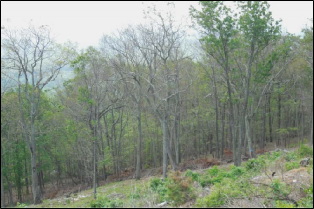
Description of Damage
Once spring arrives, cankerworm larvae devour opening buds and new leaf growth (Fig. 3). Damage begins as small holes in leaves that grow rapidly in size. As time progresses, the larvae will devour entire leaves, eating all but the midrib and leaf veins (Fig. 5). During heavy defoliation, tiny pellets of frass can be found under impacted trees, creating a nuisance in urban environments. Mature, healthy trees are able to withstand a single season of complete defoliation with little long-term effect on tree health. However, multiple consecutive years of defoliation can cause long-term injury. If trees are already declining due to other stress factors such as drought, disease, or other pest pressure, then defoliation by the fall cankerworm can be an inciting factor that starts the decline process and can lead to tree mortality.
Control
Biological controls help regulate cankerworm numbers, including Telenomus alsophilae, a type of wasp that parasitizes egg masses, and ground beetles in the genus Calasoma that devour larvae. While natural enemies generally keep the cankerworm population under control, occasional outbreaks occur. One way to combat an infestation is to treat with a registered insecticide following recommendations found in the current Horticulture and Forest Crops Pest Management Guide (VCE Publication 456-017) for commercial plantings, or in the Home Grounds and Animals Pest Management Guide (VCE Publication 456-018) for homeowners. As with all pesticides, follow the label instructions carefully with regards to rates and precautions.
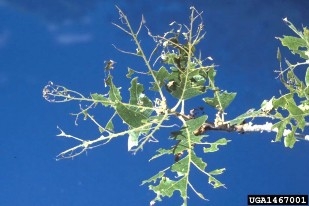
One commonly-used biologically-based pesticide, Bacillus thurgingiensis var. kurstaki (Btk), should be sprayed early in the season when larvae are first noticed on the leaves. Tree banding is used to monitor adult fall cankerworm populations and may also be used as a physical control method for individual landscape trees.
References
Asaro, C. and L.A. Chamberlin. 2015. Outbreak history (1953-2014) of spring defoliators impacting oak-dominated forests in Virginia, with emphasis on gypsy moth (Lymantria dispar L.) and fall cankerworm (Alsophila pometaria Harris). American Entomologist 61: 174-785.
Ciesla, W.M., and C. Asaro. 2013. Fall cankerworm. USDA Forest Service, Forest Insect and Disease Leaflet #182, 8 p.
Virginia Cooperative Extension materials are available for public use, reprint, or citation without further permission, provided the use includes credit to the author and to Virginia Cooperative Extension, Virginia Tech, and Virginia State University.
Virginia Cooperative Extension is a partnership of Virginia Tech, Virginia State University, the U.S. Department of Agriculture (USDA), and local governments, and is an equal opportunity employer. For the full non-discrimination statement, please visit ext.vt.edu/accessibility.
Publication Date
February 5, 2021



